Ever tried sticking a picture frame and ended up with a loose bond? Can Loctite provide that strong, reliable fix on wood? Let’s dive into the world of Loctite and wood applications!
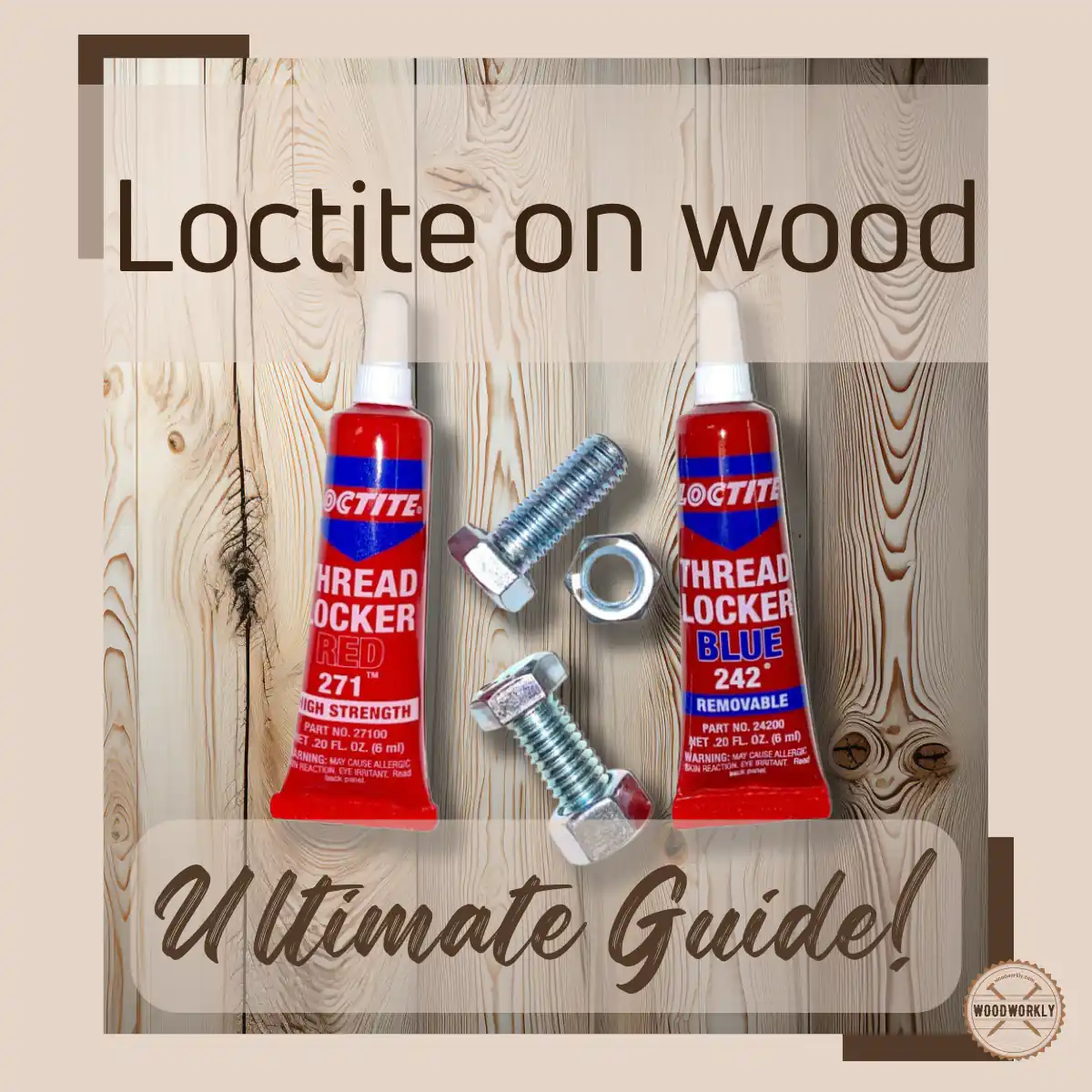
Selecting the right glue is important in any woodworking project. Loctite super glue is useful to assemble models, decorative items, and other objects tightly.
It works well with leather, fabric, cardboard, paper, metal, ceramic, and many other materials.
But, when it comes to woods, you’re probably curious about using Loctite on wood.
I had the same question and I have contacted experts and professionals of Loctite products to use it on wood projects.
So, let’s find out, Does Loctite work on wood?
Yes, Loctite works well on wood since it sets quickly and makes a strong unbreakable bond with any kind of wood. Loctite is a premium adhesive for indoor and outdoor woodwork. It prevents clogging and spillage. Apply Loctite sparingly and press wood parts and hold for 1-2 minutes.
But that’s a quick snapshot of the question.

So, in this article, we’ll deeply discuss does Loctite work on wood, how strong is Loctite on wood, how to use Loctite on wood, and how to remove Loctite from wood as well.
Furthermore, I’ll answer some frequently asked questions as well.
Let’s jump in!
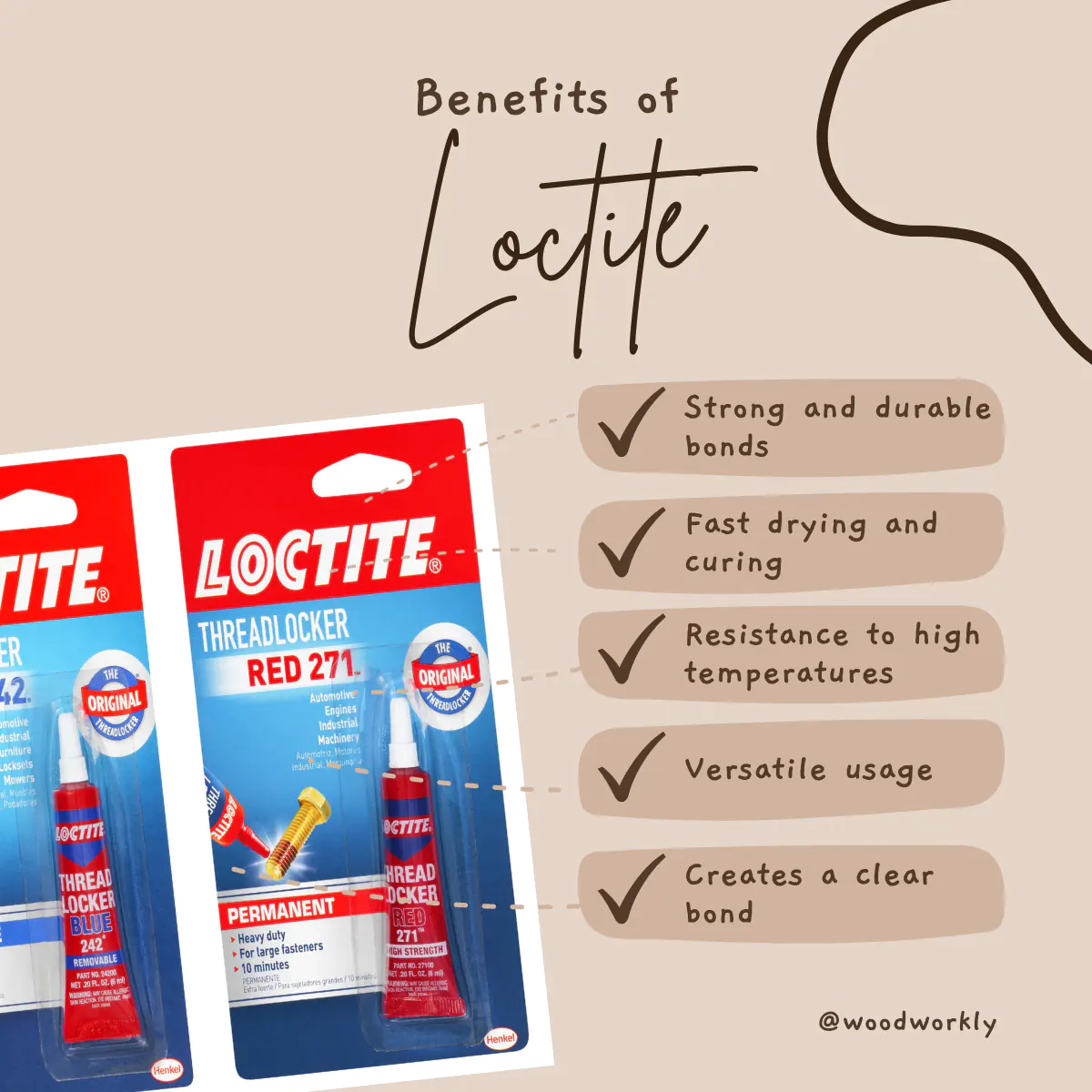
Can You Use Loctite Glue on Wood?
Yes, You can use Loctite glue on any type of wood. It bonds well with wood to make a strong bond with high impact resistance.
Loctite bonds on the wood are capable of tolerating extreme weather conditions, environmental impacts, and much more.
Therefore, Loctite glue can use for both interior and exterior woodworking projects.
Loctite can apply to outdoor furniture to make them protected from environmental elements.
Loctite has good chemical and moisture resistance, and it can tolerate freezing temperature levels which makes it super useful for any woodwork and furniture.
Loctite is a cyanoacrylate superglue that can reach difficult places of wood furniture because of its long pinpoint nozzle.
This makes Loctite a finger-friendly glue. Even a beginner in wood storing can use Loctite glue with ease because of its excellent features.
Loctite glue reacts fast with wood fibers and makes a tight unbreakable bond quickly.
This is why the setting time of Loctite glue on wood is only 15 – 30 seconds with no clamping.
Loctite glue has an impressive reputation for strength and durability.
You know, I once repaired an old, worn-out bookcase using nothing but Loctite and some patience.
It worked like a charm, and the bookcase is still holding strong, brimming with books as we speak.

Which Loctite Glue to Use
There are several options when it comes to choosing a Loctite product for your wood project.
If you’re looking for something quick and strong bond with wood, the Loctite Super Glue might be your best bet.
This high-strength adhesive forms a powerful bond within seconds, and it works well on a variety of surfaces.
For projects that require a little more flexibility, like if you’re working with softwood that may expand and contract with changes in humidity, Loctite’s Polyurethane Wood Glue is a fantastic option.
This adhesive creates a slightly more flexible bond, allowing your woodwork to breathe a bit.
And it’s waterproof, making it perfect for outdoor projects.
I recall the time I was working on a DIY jewelry box for a friend’s birthday gift. It involved attaching small pieces of painted metal to the wooden box.
After a little research, I ended up using Loctite’s Epoxy Plastic Bonder, which is designed for bonding different materials together.
I was truly impressed by how well it worked. The metal accents are still firmly attached, and my friend still uses the box daily.
Does Blue Loctite Work on Wood?
Blue Loctite is primarily designed to secure and seal bolts, screws, and other fasteners that you might want to loosen from time to time.
It’s a medium-strength, removable threadlocker that’s great for maintaining the tightness of these fasteners without making them permanent.
So, when talking about using it on wood, blue Loctite is not the best fit for all situations.
However, if you’re using metal screws in a woodworking project and want to prevent them from loosening due to vibration or wear and tear, Blue Loctite can indeed be your friend.
The Right Place for Blue Loctite
Let me share a story. I once built a wooden rocking chair, a cozy little project.
As much as I loved how it turned out, I had a recurring issue—the screws in the joints kept loosening due to the constant motion.
It was then that I turned to Blue Loctite. I applied it to the threads of the screws before fastening them, and voila! The problem was solved.
The screws remained secure, but I could still remove them with some effort if needed.
Does Threadlocker Work on Wood?
Threadlockers are designed primarily for metal fasteners, like nuts, bolts, and screws.
Threadlockers, like Loctite Blue, are not formulated to bond wood.
If you’re looking to glue pieces of wood together, you would be better off using a wood-specific adhesive, such as wood glue or polyurethane adhesive.
These are designed to create strong, durable bonds between wooden surfaces.
Their primary function is to prevent loosening due to vibrations and to protect against corrosion.
So, can you use them on wood? The answer isn’t a straight “yes” or “no”, but more of an “it depends.”
When and How to Use Threadlocker on Wood
In my own experience, I’ve found threadlocker can be beneficial in some wood applications. Let me paint a picture for you.
Imagine you’re working on a wooden table, and you have some metal bolts and screws integrated into the design.
Over time, due to regular usage, these screws may start to loosen.
This is where a threadlocker can come in handy.
By applying it to the threads of these metal fasteners, you can ensure they remain snugly in place, even amidst regular use and vibration.
In this scenario, the threadlocker isn’t directly acting on the wood but instead helping the metal fasteners do their job better within the wooden structure.
Loctite Alternatives for Wood
For bonding wood pieces together without the involvement of screws or bolts, other types of Loctite adhesives, like Loctite Super Glue or Loctite Polyurethane Wood Glue, could be a better option.
They’re designed to create a strong bond between surfaces and are more suited for typical woodworking projects.
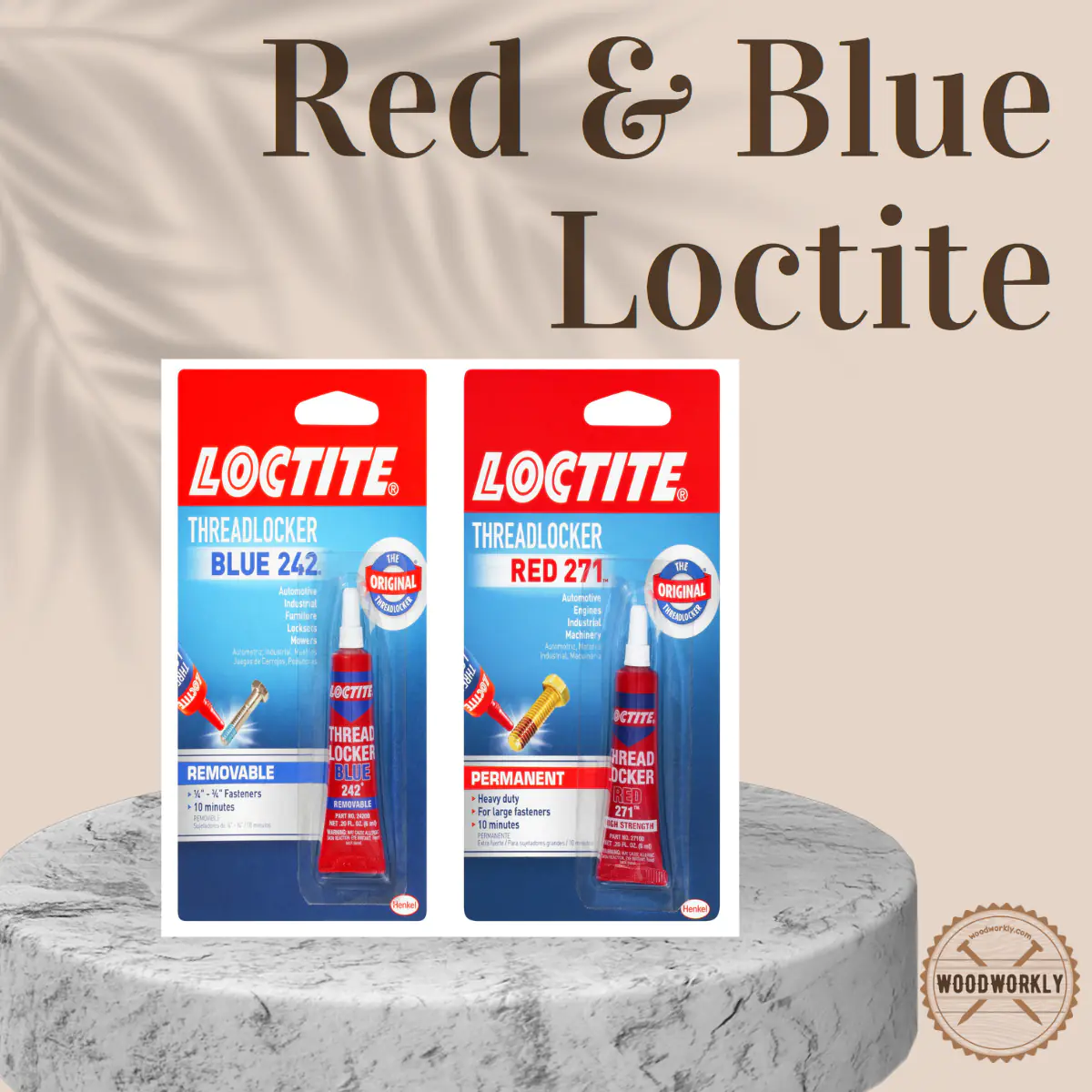
Loctite On Wood: Uses
Loctite Glue is useful when,
- Assembling wood parts without clamping
- Filling gaps and cracks
- Mending wood parts
- Waterproofing the wood
- Protecting wood from chemicals and extreme temperatures
Benefits Of Using Loctite On Wood
Here’re some qualities and advantages of Loctite glue,
- Low odor
- Quick drying adhesive
- Transparent
- Anti-clog
- Works on both porous and nonporous kinds of wood
- Able to reach difficult places
- React with water and atmospheric moisture
- No clamping is required
- Easy to apply
- High tensile strength
- Able to apply on vertical surfaces
Use Of Loctite in Wet Conditions
You can use Loctite even in wet conditions since it reacts with moisture because it is a cyanoacrylate adhesive that needs moisture to cure.
When the adhesive is inside the container, it does not get contact with water or atmospheric moisture. Therefore, it’ll be in a liquid state.
But as soon as it comes out of the lid when applied, cyanoacrylate adhesive reacts instantly with atmospheric moisture and starts the curing process.
Not like other adhesives that cure by evaporation, cyanoacrylate adhesives including Loctite cure with the presence of moisture.
This is why Loctite works well with any material. It doesn’t care whether it’s wood, ceramic, metal, glass, or anything.
Even If there’s moisture outside, it bonds with almost any surface. Loctite’s moisture curing process is useful to work great with any kind of wood.
Moisture is the accelerator for the bonding and curing process of Loctite glue.
Once the Loctite glue is cured, it’s non-toxic, but never use Loctite on kitchen utensils and children’s toys because it is not food safe.
So, let’s find out how Loctite works on different woodworking applications.
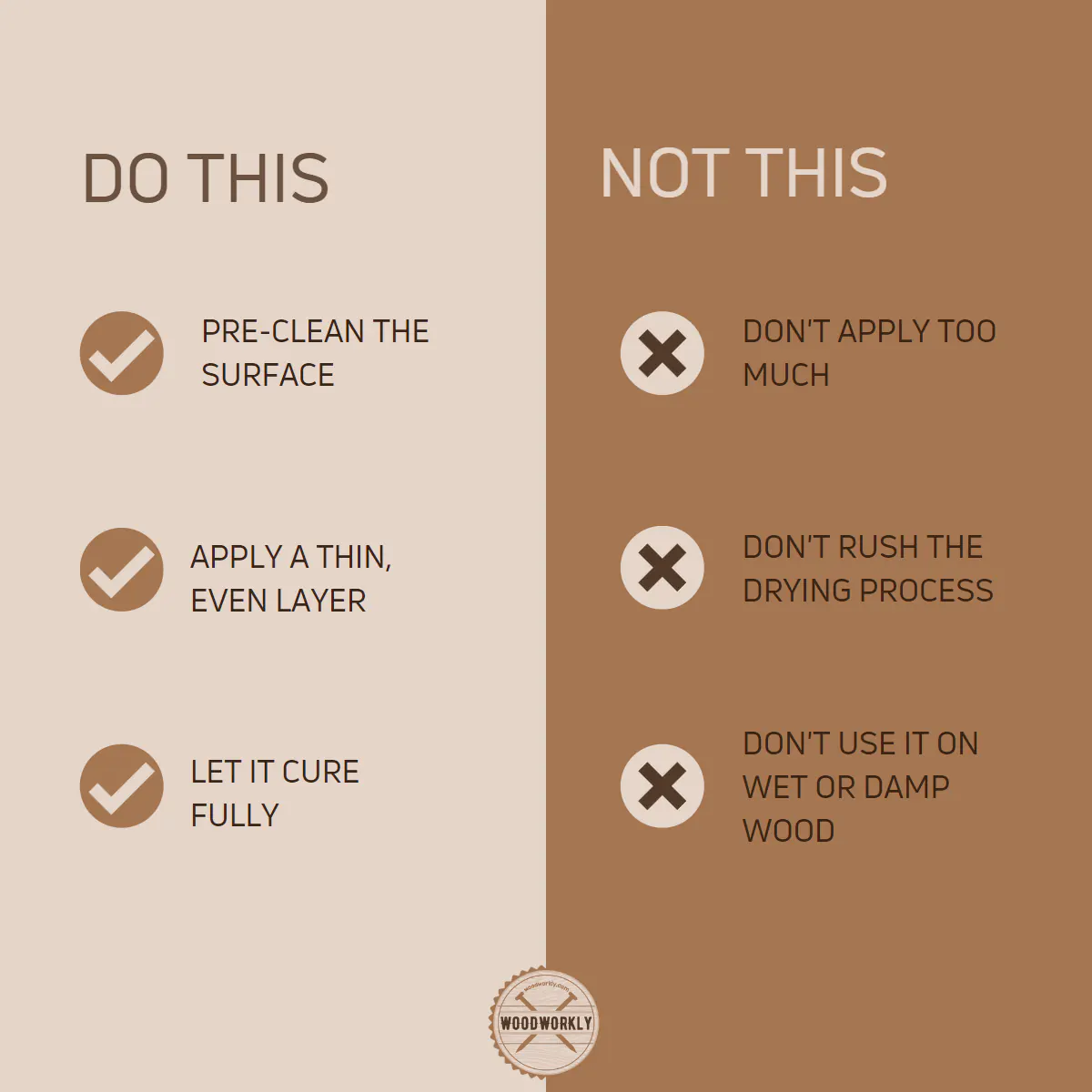
Can You Use Loctite Glue on Metal to Wood?
Yes, you can use Loctite glue on metal to wood without any issue.
Loctite ultra-control super glue is the best product to glue metal to wood.
Loctite makes a strong bond between metal and wood surfaces which has good resistance against impact, vibrations, shock, and extreme temperatures.
The bond is also resistant to moisture and chemicals.
If you’re willing to assemble metal parts or metal legs to your wood tabletop, Loctite super glue is the best product you should go with.
It will improve the dimensional stability of furniture by making an unbreakable bond with high performance.
Plus, Loctite doesn’t need clamps to assemble metal to wood. The application is also simple.
Can You Use Loctite on Wood Screws?
Yes, you can use Loctite glue on wood screws. Wood screws tight well with any surface once it gets contacted with Loctite glue.
Loctite wood glue helps to lubricate the hole and makes the wood screw go in easier.
But if the screw is metal, never use Loctite because Loctite absorbs moisture from the outside and makes the metal screw rust.
Especially in a screw hole, there’s no way to escape from moisture. But with wood screw
Loctite does such a wonderful job by making good adhesion less than 30 seconds after the application.
The Right Loctite for the Job
When using Loctite on wood screws, it’s essential to choose the right product.
Loctite Threadlocker Blue 242 is a good option for wood screws because it offers a secure hold but also allows for disassembly with hand tools if necessary.
A Word of Caution
It’s important to note that Loctite is not a substitute for proper screws or proper screw fitting in woodworking.
Loctite should not be used to fix a stripped screw hole in wood; instead, repair the hole properly, either by using a larger screw or by filling and re-drilling the hole.
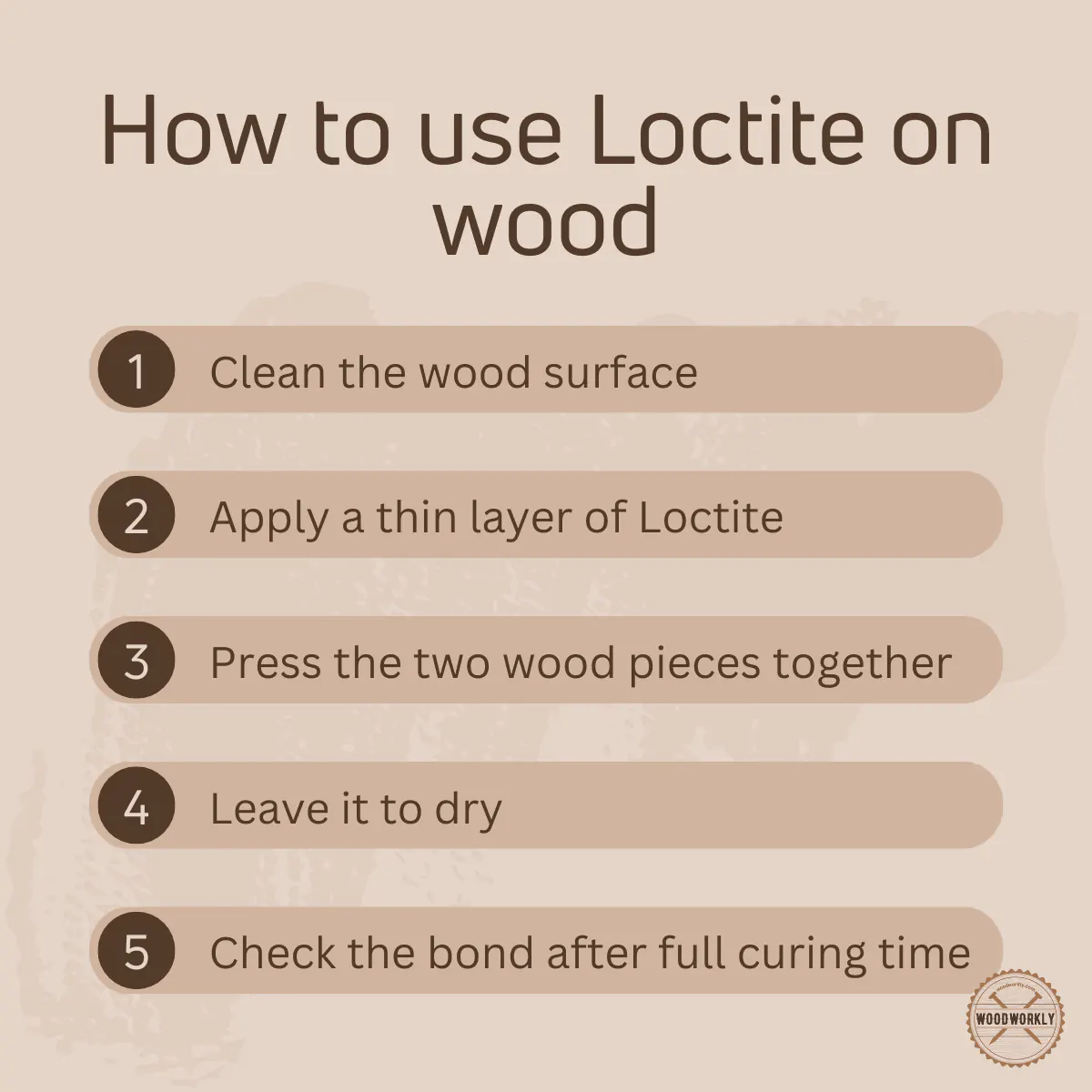
How Strong Is Loctite on Wood?
Loctite is extremely strong on wood. Loctite builds 3500 PSI strong bond with wood within 30 seconds.
Loctite bonds can withstand extremely high and low temperatures. It offers humid resistance, a tough bond that dies in less than 10 minutes.
It can withstand heavy loads with few drops.
The strength of the Loctite bond does not vary with the wood type. It makes long-lasting bonds for both indoor and outdoor woodworks and furniture.
It is a heavy-duty cyanoacrylate that works well on both porous and non-porous wood providing strong adhesion.
Loctite’s strong bond on wood is useful when assembling wood parts, filling gaps, and cracks, and restoring and repairing wood.
Clamping is not needed for the adhesion process and sets more quickly than many other ordinary adhesives.
So, let’s find out how to use Loctite on wood to get the desired outcome as you wish.
Supplies You Will Need to Use Loctite On Wood
- Loctite glue
- Woodwork or furniture
- Wood parts or materials
- 220 grit sandpaper
- Damp cloths
Grab the above tools and materials from a quality manufacturer and get ready to start the application process.
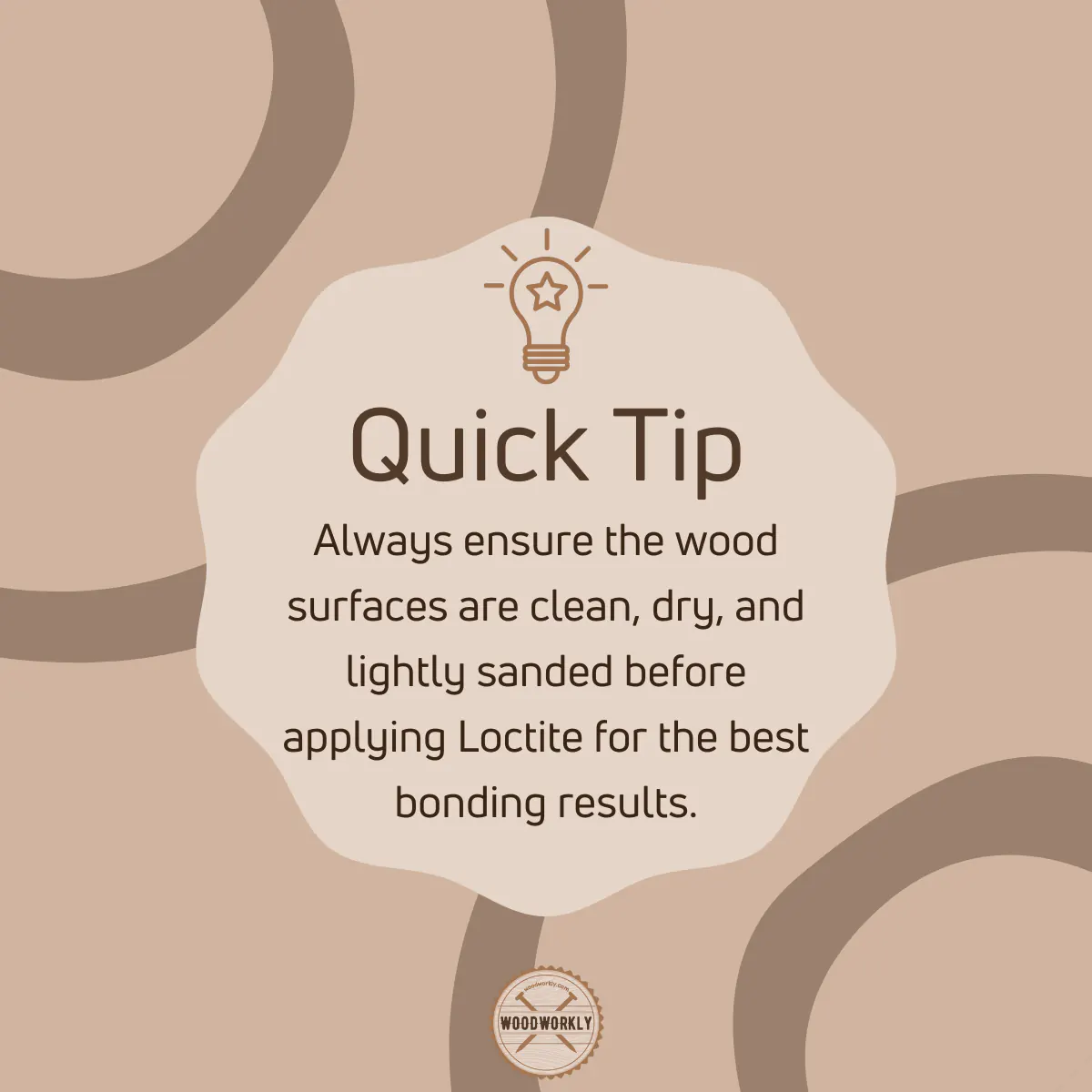
How To Use Loctite on Wood?
Loctite can be used for any kind of wood, woodwork, or furniture. It is easy to apply because of having an extra-long pinpoint nozzle that has anti-clog capabilities.
Even a beginner in woodworking can use Loctite to assemble wood parts and build and repair household objects without any issues because of its user-friendliness.
Here’re the steps you need to follow when using Loctite on wood,
- Prepare the area
- Clean the wood
- Sand and remove sawdust
- Apply Loctite glue
- Clean the excess
So, let’s discuss each of the above steps separately to get a better explanation of applying Loctite glue on wood.
1. Prepare The Area
Before starting the application process, you need to select a well-ventilated area for the project.
Loctite releases some bad fumes and odor until it is cured properly which can cause respiratory problems. Once it is fully cured, Loctite is non-toxic.
Therefore, wear a mask and take your woodwork or furniture outside or ventilated area like a garage to do the job without causing any problems.
Plus, Loctite needs an atmosphere with significant moisture content to cure properly. Moisture works as an accelerator for the Loctite to set quickly with strong bonding with bond.
Therefore, an open area usually works best when using Loctite glue.
2. Clean The Wood
Cleaning is an essential step in the Loctite application process because if dust and debris get trapped inside of the Loctite, we’re unable to get the maximum bonding strength out of it, and removing is also such a difficult task.
Therefore, the surfaces need to be clean and nice before you reach the application step.
Wipe the entire wood surface with clean dump cloths without missing any spots, Loctite bonds well with clean woods.
3. Sand and Remove Sawdust
After cleaning the wood properly, sand the entire wood surface with 220 grit sandpaper without missing any spots.
Loctite loves to get in contact with smooth surfaces than random irregular surfaces.
When the surface is smooth, wood glue will easily spread and be able to provide excellent adhesion properties.
Never use coarse grit sandpapers because they might damage some woods. Fine grit ones are the best sandpapers that go well in this task.
Clamping is also can be difficult when the surface is not smooth.
Once you’re done with sanding, clean the entire surface with dump cloths to remove sawdust and other residues well.
When the surface is nice, clean, and smooth you’re good to move on to the application step.
4. Apply Loctite Glue
Squeeze and take Loctite sparingly to the surfaces that need to be bonded. Then hold and press two parts together for 2 – 3 minutes until they’re tightened.
Make sure not to make any individual movements during this period for a stable bond.
Applying a small amount of Loctite is a must because if the wood glue layer is too thick, its adhesion properties will be reduced and take a longer time to bond or sometimes not bond at all.
Therefore, always go for a thin layer of wood glue by using Loctite sparingly.
After 2 – 3 minutes let them sit for another 2 – 6 minutes. During the setting period, the Loctite will initiate the moisture curing process by absorbing the moisture of the atmosphere and hardens as quickly as possible.
Loctite can use to bond wood with metal, paper, rubber, ceramic, glass, plastic, and many more.
It makes heavy duty strong bond than most other adhesives with superior performances without getting spillage and clogging.
Loctite makes an unbreakable bond between two surfaces that resist moisture and chemicals.
Loctite can use to fill gaps and cracks and harden and hide cracks during this period.
After making a strong bond, let Loctite glue cure overnight to get the maximum out of it.
Once you’re done applying Loctite, store it in a sealed container without letting contact with air or moisture.
5. Clean The Excess
After applying Loctite on wood, take a look and note the excess amounts of Loctite on the surface and clean quickly them before hardens.
You can use acetone to remove excess Loctite and wipe off the residue and other things from the surface to make it look nice and clean.
Congratulations! Now you know how to use Loctite on wood without making any errors.
Loctite is a super user-friendly product that reaches any difficult place because of its extra-long pinpoint nozzle and finger-friendly handling properties.
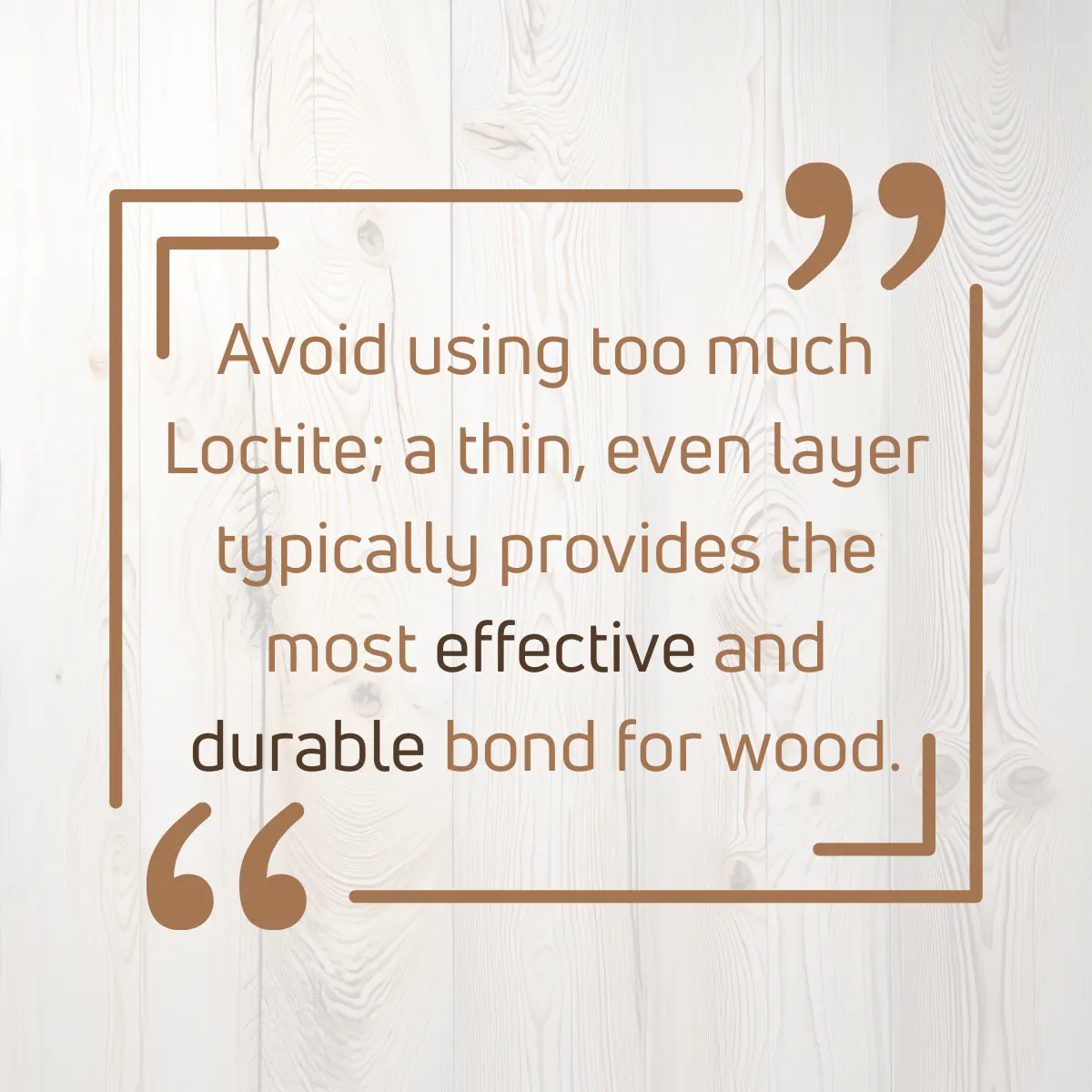
How To Remove Loctite on Wood?
Once the Loctite gets hardened and cured, it can be a nightmare to remove it from the wood.
A Loctite bond is hard to break, and you need to be more careful to remove it without harming the wood surface.
With the wrong removing process, the wood can get easily damaged and ruin the entire woodwork.
There’re two main methods you can use to remove Loctite on wood without getting things messed up. They are,
- Acetone method
- Sanding method
Now discuss them in detail to remove Loctite effectively on wood.
1. Acetone Method
In the acetone method, you can dissolve Loctite in acetone and make it softens and remove it firmly.
If you’re unable to find acetone, polish remover or vinegar is also good for the job.
- Put some acetone into a cotton soft cloth and soak it.
- Apply the cotton cloth to the glued area and saturate it.
- Rub firmly until Loctite glue gets softened and dilute with acetone.
- Repeat the process until all the Loctite glue gets removed.
- Clean the surface with another soft cotton cloth to remove excess acetone and other glue residues.
2. Sanding Method
Apart from using the acetone method, you can use the sanding method to remove Loctite from wood.
But you need to be extra careful in this method because higher grit sandpaper can scratch the wood surface and destroy its appearance.
Always go for the finer grit ones.
Here’re the steps you need to follow to remove Loctite on wood by sanding,
- Sand glued area firmly until it gets removed
- Clean the surface while you’re sanding to eliminate dust and residue
- Once the glue is removed completely, repair the surface again to fill gaps and cracks
Is Loctite Epoxy Good on Wood?
Loctite epoxy works well on wood. It acts as a sealant and filler on wood by increasing the wood’s durability and strength.
Loctite epoxy creates a long-lasting bond that is waterproof and easy to clean.
Usually, Loctite epoxy comes with dry clear or with a yellow tint. By adding powdered or liquid colorant you’ll be able to match its color as you want for the wood surface.
Loctite epoxy comes with an extra-long nozzle same as Loctite glue, that can reach difficult places easily and is able to mix hardener and resin automatically.
Loctite epoxy sets in less than 1 minute. It can use for both indoor and outdoor woodworks and furniture to fill gaps, and cracks and for the wood restoring process.
Can You Use Red Loctite on Wood?
Red Loctite is not good to use for woods because it is specially designed to seal and lock threaded fasteners well and to resist shock and vibration.
It has nothing to do with wood surfaces.
Even though red Loctite adheres with wood, it is not specialized for that. It only works well with metal surfaces by preventing corrosion, leaks, and rusting.
You need to have a good understanding about which color Loctite product is right for your project.
How Long Does Loctite Take to Dry on Wood?
Loctite dries on wood in less than 10 minutes. Loctite takes 24 hours to complete the curing process on wood.
It dries super-fast on wood surfaces.
But this drying time can differ due to the environmental humidity, climate changes, and more. But usually, it won’t take more than 20 minutes to dry completely.
By applying a thin layer of Loctite, the drying process will be much faster, and always apply Loctite sparingly to work efficiently.
Loctite goes through moisture curing when the moisture is present. The curing time takes around 24 hours.
So, better to keep it overnight to complete the job. Loctite does not shrink or expand during curing and once it is cured, you’ll be able to maximum bonding strength of it.
That’s it folks! Now you know does loctite work on wood and how to use it properly.
Let’s answer some frequnetly asked questions.
FAQs
Can I use Loctite to fix a stripped screw hole in wood?
No, Loctite should not be used to fix a stripped screw hole in wood. A more effective repair would involve using a larger screw or filling and re-drilling the hole.
Is Loctite Superglue Waterproof?
Yes, certain Loctite superglues such as Loctite Super Glue Ultra Gel Control are water-resistant, making them suitable for projects that require resistance to moisture, but submersion in water for extended periods may weaken the bond.
How to attach aluminium to wood with Loctite?
When attaching aluminium to wood, it’s best to use a strong adhesive like Loctite PL Premium Polyurethane Construction Adhesive. Clean and dry the surfaces, apply the adhesive to the aluminium, press it onto the wood, and allow the adhesive to cure as per instructions.
What is the dry time for Loctite Super Glue?
Loctite Super Glue sets in just a few seconds, but for maximum bond strength, it’s best to allow the adhesive to fully cure for 24 hours before subjecting the glued item to any stress.
Did I cover all you wanted to know about: Does Loctite Work on Wood?
In this article I have dived deep does Loctite work on wood, how strong is Loctite on wood, how to use Loctite on wood properly, and also how to remove it from the surface as well.
Loctite adhesives, like Loctite PL Premium Polyurethane Construction Adhesive and Loctite Epoxy Extra Time, work excellently on wood, offering strong, durable bonds. However, products like Loctite’s Threadlocker aren’t ideal for wood applications. Always choose the product based on the specific project requirements.
Loctite works great on any kind of wood. it can use to assemble wood parts, repair and restore wood, and fill gaps and cracks in the wood.
Loctite sets within 2 -3 minutes after the application and provides an unbreakable bond that can resist moisture, chemicals, and other environmental elements.
Therefore, Loctite is well suited for both interior and exterior furniture.
Furthermore, I have answered some frequently asked questions as well.
Hope you have gained pretty good knowledge about using Loctite on wood from this article. Use Loctite on your next wood repairing project and give it a try!